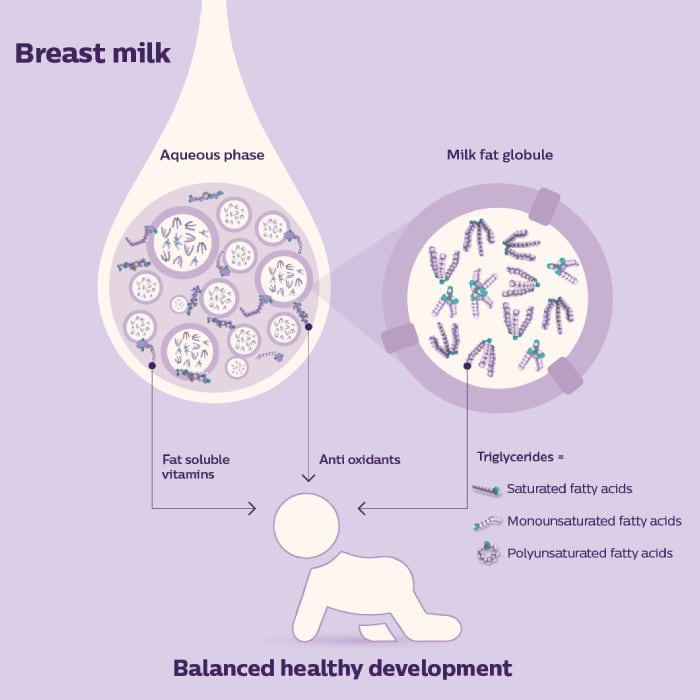March 2021
Breast milk lipids benefit intestinal health

The fats in mother's milk offer more than energy. Studies show they are important in protecting baby’s intestines from inflammation and disease.
Fats in human breast milk account for close to 50% of the calories that newborns ingest, up to their first 6 months. The different types of lipids and compounds help to ensure newborn's growth, the development and function of baby's neurocognitive system and the regulation of inflammation and risk of infection. These effects extend into adulthood, reducing the risk of metabolic and cardiovascular disease.
A recent study by Ramiro-Cortiijo et al. (2020) of Beth Isreal Deaconess Medical Center, Harvard Medical School - one of America's top academic medical centers - takes a closer look at breast milk lipids and fatty acids and infant development and health. Especially intestinal health.

Figure 1: Human milk composition
Energy and protection
Breast milk contains a variety of saturated, monounsaturated and polyunsaturated fatty acids - each of which are present in different concentrations. Aside from providing infants with energy, they also serve a variety of functions - from carrying fat soluble vitamins to acting as anti-inflammatory, anti-bacterial and anti-viral agents in the intestines1. See figure1.
When it comes to the saturated fatty acids, as milk matures, their concentrations change - from 53.2% in colostrum, to 62.1% in transitional milk - to 58% in mature milk. On the other hand, monounsaturated fatty acid levels remain somewhat stable throughout milk maturation, at about 45-50%.
Of the lipids in breast milk, about 16% are long chain polyunsaturated fatty acids (LCPUFAs). According to many studies, these fatty acids have developmental, cardioprotective, anti-cancer, anti-inflammatory and antioxidant functions.
Exposure to LCPUFAs has an influence on baby's intestinal development. Studies also show a possible benefit in inflammatory bowel disease and the reduction of intestinal damage. This may be explained by the effect they have on the function of the gut barrier.
Of the monounsaturated fats, 36% consist of oleic acids, which work to lower the melting point of triglycerides. This makes it possible for the milk fat globule in mother's milk to be formed, transported and metabolized.
Human milk fat globules
All these lipids travel from breast to baby in fat globules, which are at their largest during the first 24 hours after birth - and shrink in size in transitional and mature milk.
Each globule is surrounded by a tri-layered membrane containing important proteins that are key to infant health. Further research still needs to be done to fully understand the role the membrane plays in infant nutrition. However, promising clinical trials using daily milk fat globule membrane supplements in 6-12 month old infants showed close to a 50% reduction in episodes of bloody diarrhea.
Studies using bovine fat globule membranes suggests that the membranes are important to cognitive and neuronal development and to protect from bacterial infection. Other research into the membranes indicates that breast milk fat globules could also be used in the future to deliver vitamins and digestive enzymes.
Such research demonstrates the amazing complexity of breast milk and their lipids. As scientists discover more, their findings may pave the way to creating new types of therapies, which can be especially helpful for preterm babies, or babies who are dealing with critical health conditions.
Share this article:
Related Articles
Not a Healthcare Professional?
Literatur 1. J. Bruce German; Cora J. Dillard. Saturated Fats: A Perspective from Lactation and Milk Composition, Lipids, 2010; 45(10): 915-923



